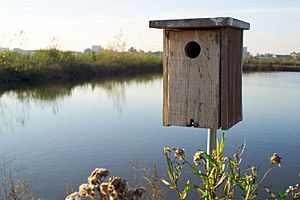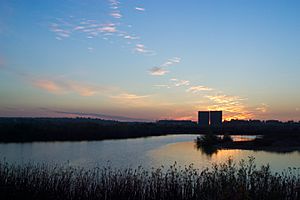San Joaquin Wildlife Sanctuary facts for kids

The San Joaquin Wildlife Sanctuary is a special place in Irvine, California. It's a large, 300-acre area of wetlands that people built to help nature. It sits near the San Diego Creek, close to where the creek flows into the Upper Newport Bay.
Contents
What is the San Joaquin Wildlife Sanctuary?
The San Joaquin Wildlife Sanctuary is a unique area of constructed wetlands. This means it's a wetland environment that was created by people, not just formed naturally. It's designed to act like a natural wetland, helping the environment in important ways.
History of the Sanctuary
This land used to be a farm in the 1950s and 1960s. Before it became a sanctuary, it was even used for duck hunting! But in 1988, people started working to bring the wetlands back. The restoration was finished in the year 2000, turning the area into the beautiful sanctuary we see today.
How the Sanctuary Helps Nature
Today, the San Joaquin Wildlife Sanctuary has two main jobs. First, it helps clean the water from San Diego Creek. Water from the creek flows through the sanctuary, and the plants and natural processes help remove harmful substances called nitrates. This makes the water cleaner before it reaches the bay.
Second, the sanctuary provides a safe and welcoming home for many different kinds of birds and other wildlife. It's a perfect spot for birds to find food, build nests, and raise their young. The Irvine Ranch Water District owns the land. They also have a water treatment plant nearby, but the cleaned water from that plant doesn't go into the sanctuary itself.
How the Wetlands Clean Water
Inside the sanctuary, water from the creek flows through a system of ponds. These ponds were built in 1997 and are surrounded by tall plants called bulrushes. The water slowly moves through these ponds, and the plants and soil naturally filter out the nitrates. From time to time, the ponds are drained and new seeds are planted to keep the system working well. The land around the ponds is also covered with native plants that belong in this area.
A Home for Birds and Plants
At one edge of the sanctuary, there's a small hill that acts as an arboretum. An arboretum is like a garden for trees, but these trees are not native to the area. They were planted for Earth Day in 1990. The whole sanctuary, including the plants and ponds, has been designed to attract birds. There are even special nesting boxes for birds to use.
Scientists and bird watchers do monthly counts of the birds here. They have found over 120 different types of birds! These include many cool species like hawks, swallows, roadrunners, hummingbirds, herons, egrets, pelicans, sandpipers, ducks, geese, and kingfishers. It's a great place to see many different kinds of birds in one spot.
Visiting the Sanctuary
The San Joaquin Wildlife Sanctuary is open to everyone every day during daylight hours. It's a wonderful place to explore nature. There are over 10 miles of hiking trails, and they are all designed to be easy for wheelchairs to use.
When you visit, you'll find free parking, restrooms, benches where you can rest, and maps to help you find your way around the trails. There's also a historic building called the Duck Club. This building was moved to the site in the 1940s and was once used by hunting clubs. Now, it's a free meeting place for non-profit groups. The Audubon Society, a group that cares about birds, has an office in another building nearby, which used to be the bunkhouse for the Duck Club.



